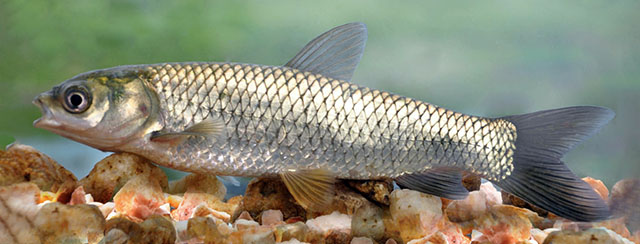
|
Ctenopharyngodon idella (Valenciennes, 1844) Grass carp |
||
| Amour blanc, Carpe amour, Carpe herbivore | ||

|
|
photo by
Ramani Shirantha |
| Family: | Xenocyprididae (East Asian minnows) | |||
| Max. size: | 150 cm TL (male/unsexed); max.weight: 45 kg; max. reported age: 21 years | |||
| Environment: | benthopelagic; freshwater; brackish; depth range 0 - 30 m, potamodromous | |||
| Distribution: | Asia: Eastern China and Russia (Ref. 48) in eastern Siberia, Amur River system (Ref. 1441). Widely transported around the world (Ref. 7248). Persists only in Europe by stocking (Ref. 59043). Introductions often brought with it the parasitic tapeworm Bothriocephalus opsarichthydis (synonym of B. acheilognathi) (Ref. 12217). Several countries report adverse ecological impact after introduction. | |||
| Diagnosis: |
Dorsal spines (total): 0-0; Dorsal soft rays (total): 10-11; Anal spines: 0-0; Anal soft rays: 10-14. Diagnosis: No barbels; snout very short, its length less than or equal to eye diameter; postorbital length more than half head length (Ref. 4967). 18 soft rays for caudal fin (Ref. 40476). Diagnosed from rather similar species Mylopharyngodon piceus by having the following characters: body olive to brassy green above, silvery white to yellow below; body cylindrical; pharyngeal teeth laterally compressed, serrated, with a groove along grinding surface, usually in two rows, 2,5-4,2 (Ref. 59043). Description: Body sub-cylindrical (Ref. 52193). Head pointed; mouth terminal; eyes nearer tip of snout than hind margin of head, lateral in position (Ref. 52193). Dorsal fin with 3 unbranched and 7-8 branched rays; anal fin with 3 unbranched and 8 branched rays; dorsal fin short, midway between tip of snout and end of caudal peduncle, origin slightly in front of pelvic fins (Ref. 52193). Scales in lateral line 37-42; 16 scales around caudal peduncle (Ref. 52193). Colouration: Body silvery, head and fins dark grey (Ref. 52193). |
|||
| Biology: | Adults occur in lakes, ponds, pools and backwaters of large rivers (Ref. 5723), preferring large, slow-flowing or standing water bodies with vegetation (Ref. 52193). Tolerant of a wide range of temperatures from 0° to 38°C, and salinities to as much as 10 ppt and oxygen levels down to 0.5 ppm (Ref. 52193). It feeds on higher aquatic plants and submerged grasses; takes also detritus, insects and other invertebrates. One of the world's most important aquaculture species and also used for weed control in rivers, fish ponds and reservoirs (Ref. 9987). Spawn on riverbeds with very strong current (Ref. 30578). Utilized also fresh and eaten steamed, pan-fried, broiled and baked (Ref. 9987). Considered as a pest in most countries because of the damages made to submerged vegetation (Ref. 43281). | |||
| IUCN Red List Status: | Least Concern (LC); Date assessed: 30 March 2020 Ref. (130435) | |||
| Threat to humans: | potential pest | |||
| Country info: | Theoretically present only in fish culture systems but may occur in certain canals. Does not reproduce naturally in the thermal and hydraulic conditions of the metropolitan rivers. Is produced in hatcheries for stocking in culture ponds and sometimes to control the vegetation in the canals (Ref. 30578). Its introduction is forbidden but encountered in Rhin, Loire, in the low part of Durance, in Sélune and some east rivers (Ref 40476). Also Ref. 2163. | |||